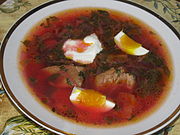Sorrel soup
 Polish sorrel soup with egg and croutons | |
| Alternative names | Green borscht, green shchi, green soup |
|---|---|
| Type | Soup |
| Region or state | Eastern and Northeastern Europe |
| Serving temperature | Hot or cold |
| Main ingredients | Water or broth, sorrel leaves, and salt |
Sorrel soup is made from water or broth, sorrel leaves, and salt.[1][2][3][4][5] Varieties of the same soup include spinach, garden orache, chard, nettle, and occasionally dandelion, goutweed or ramsons, together with or instead of sorrel.[1][2][3][6][7][8] It is known in Ashkenazi Jewish,[4] Belarusian,[7] Estonian, Hungarian, Latvian,[9] Lithuanian, Romanian, Armenian, Polish,[5] Russian[1][3] and Ukrainian[6][8] cuisines. Its other English names, spelled variously schav, shchav, shav, or shtshav, are borrowed from the Yiddish language,[4] which in turn derives from Slavic languages, like for example Belarusian шчаўе, Russian and Ukrainian щавель, shchavel, Polish szczaw. The soup name comes ultimately from the Proto-Slavic ščаvĭ for sorrel.[citation needed] Due to its commonness as a soup in Eastern European cuisines, it is often called green borscht, as a cousin of the standard, reddish-purple beetroot borscht.[1][6][7][8] In Russia, where shchi (along with or rather than borscht) has been the staple soup, sorrel soup is also called green shchi.[10][11] In old Russian cookbooks it was called simply green soup.[2][3]
Sorrel soup usually includes further ingredients such as egg yolks or whole eggs (hard-boiled or scrambled), potatoes, carrots, parsley root, and rice.[1][3][12] A variety of Ukrainian green borscht also includes beetroot.[11] In Polish, Ukrainian, Belarusian, and Russian cuisines, sorrel soup may be prepared using any kind of broth instead of water.[1][3] It is usually garnished with smetana, an Eastern European variety of sour cream.[1][3] It may be served either hot or chilled.
Sorrel soup is characterized by its sour taste due to oxalic acid (called "sorrel acid" in Slavic languages) present in sorrel. The "sorrel-sour" taste may disappear when sour cream is added, as the oxalic acid reacts with calcium and casein. Some may refer to sorrel flavor as "tannic," as with spinach or walnuts.
-
Green borscht with egg and sour cream
-
Green borscht made with spinach instead of sorrel and with potatoes
-
Ukrainian green borscht including both sorrel and beetroot
See also
[edit]References
[edit]- ^ Jump up to: a b c d e f g Burlakoff, Nikolai (2013). The World of Russian Borsch: Explorations of Memory, People, History, Cookbooks & Recipes. North Charleston, SC: Createspace Independent Pub. ISBN 978-1484027400.
- ^ Jump up to: a b c Екатерина Авдеева. Ручная книга русской опытной хозяйки. СПб, 1842 [Yekaterina Avdeeva. A Handbook of the Russian experienced housewife. St. Petersburg, 1842]
- ^ Jump up to: a b c d e f g Елена Молоховец. Подарок молодым хозяйкам. 1-е издание, 1861, с. 65 [Elena Molokhovets. A Gift to Young Housewives. First Russian edition, 1861, p. 65]
- ^ Jump up to: a b c Marks, Gil (2010). "Schav". Encyclopedia of Jewish Food. Hoboken: John Wiley & Sons. ISBN 978-0-470-39130-3.
- ^ Jump up to: a b Ochorowicz-Monatowa, Maria (1913). Uniwersalna książka kucharska z ilustracyami i kolorowemi tablicami odznaczona na wystawie hygienicznej w Warszawie w 1910 r. : przeszło 2200 skromnych i wytwornych przepisów gospodarskich i kuchennych z uwzględnieniem niezbędnych warunków odpowiedniej dyety codziennej hygieny oraz kuchni jarskiej (in Polish). Warszawa / Lwów: E. Wende i S-ka.
- ^ Jump up to: a b c Artyukh, Lidiya (1977). Ukrayinska narodna kulinariya (Українська народна кулинарія) [Ukrainian folk cuisine] (in Ukrainian). Kyiv: Naukova dumka. p. 55.
- ^ Jump up to: a b c Chakvin, Igor; Gurko, Alexandra; Kasperovich, Galina (2014). Этнокультурные процессы Восточного Полесья в прошлом и настоящем Этнокультурные процессы Восточного Полесья в прошлом и настоящем [Ethnocultural processes of Eastern Polesie in the past and present] (in Russian). Litres. p. 78. ISBN 9785457646278.
- ^ Jump up to: a b c Guboglo, Mikhail; Simchenko, Yuri (1992). Украинцы: Историко-этнографический очерк традиционной культуры Украинцы: Историко-этнографический очерк традиционной культуры [Ukrainians: A historical ethnographic essay of the traditional culture] (in Russian). Москва: Российская академия наук, Институт этнологии и антропологии им. Н.Н. Миклухо-Маклая. p. 98.
- ^ Ošiņa, Sandra; Ošiņš, Valdis (2014). Traditional and modern Latvian foods and beverages (PDF). The Association of Latvian Rural Tourism.
- ^ Pokhlyobkin, William (2004). Национальные кухни наших народов [National cuisines of our peoples] (PDF) (in Russian). Moscow: Centrpolograf. p. 28. ISBN 5-9524-0718-8. Щи
- ^ Jump up to: a b Cookery Кулинария (in Russian). Москва: Госторгиздат (Soviet state publishing house for business literature). 1955–58. Retrieved 2 August 2015. Щи, Борщ зелёный украинский
- ^ Sorrel and Pork Soup (Green Borscht) Recipe


